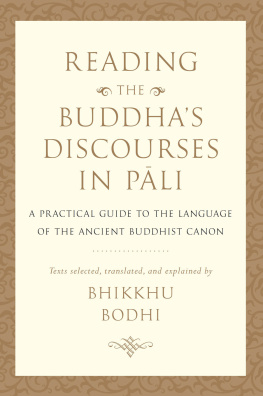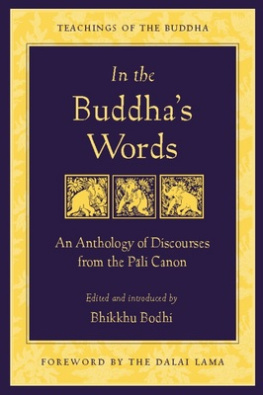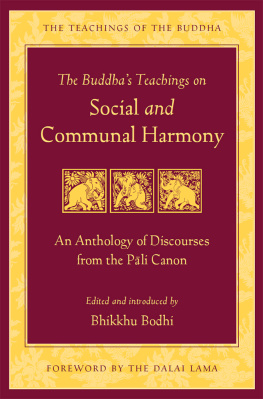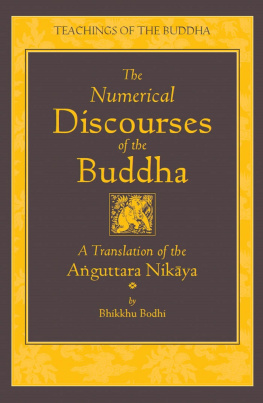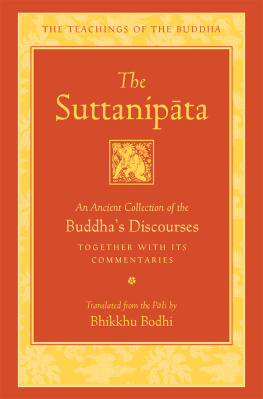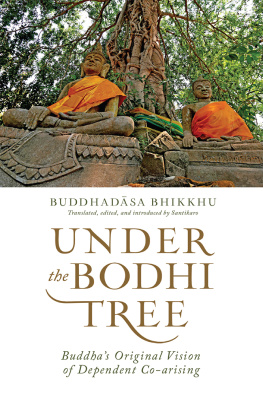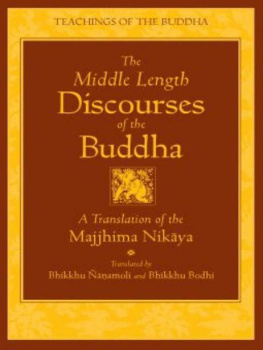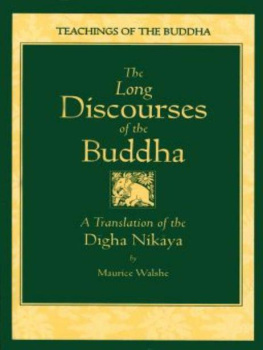Table of Contents
Dedicated to
the memory of
my teacher
Venerable Abhidhajamaharatthaguru
Balangoda Ananda Maitreya Mahanayaka Thera
(18961998)
and to the
memories of my
chief kalyanamittas
in my life as
a Buddhist monk
Venerable Nyanaponika Mahathera
(19011994)
and
Venerable Piyadassi Nayaka Thera
(19141998)
Preface
The present work offers a complete translation of the Samyutta Nikaya, The Connected Discourses of the Buddha, the third major collection in the Sutta Pitaka, or Basket of Discourses, belonging to the Pali Canon. The collection is so named because the suttas in any given chapter are connected (samyutta) by the theme after which the chapter is named. The full Samyutta Nikaya has been translated previously and published in five volumes by the Pali Text Society under the title The Book of Kindred Sayings. The first two volumes were translated by Mrs. C.A.F. Rhys Davids, the last three by F.L. Woodward. This translation, first issued between 1917 and 1930, is dated both in style and technical terminology, and thus a fresh rendition of the Samyutta Nikaya into English has long been an urgent need for students of early Buddhism unable to read the texts in the original Pali.
My own translation was undertaken in response to a request made to me in the early 1980s by then Bhikkhu Khantipalo (now Laurence Mills). This request was subsequently reinforced by an encouraging letter from Richard Gombrich, the present president of the Pali Text Society, who has been keenly aware of the need to replace the PTS translations of the Nikayas by more contemporary versions. Although this appeal came in 1985, owing to prior literary commitments, most notably to the editing of Bhikkhu anamolis translation of the Majjhima Nikaya, I could not begin my translation of the Samyutta in earnest until the summer of 1989. Now, ten years later, after numerous interruptions and the daunting tasks of revision and annotation, it has at last reached completion.
As with The Middle Length Discourses of the Buddha, this translation aims to fulfil two ideals: first, fidelity to the intended meaning of the texts themselves; and second, the expression of that meaning in clear contemporary language that speaks to the non-specialist reader whose primary interest in the Buddhas teaching is personal rather than professional. Of course, any ideas about the intended meaning of the texts themselves will inevitably reflect the subjective biases of the translator, but I have tried to minimize this danger to the best of my ability. To attempt to translate Pali into a modern Western language rooted in a conceptual framework far removed from the thought world of the ancient suttas is also bound to involve some degree of distortion. The only remedy against this, perhaps, is to recommend to the reader the study of Pali and the reading of the material in the original. Unlike English, or even Sanskrit, Pali is a highly specialized language with only one major sphere of applicationthe Buddhas teachingsand thus its terminology is extremely precise, free from intrusive echoes from other domains of discourse. It is also rich in nuances, undertones, and conceptual interconnections that no translation can ever succeed in replicating.
My translation is a hybrid based on editions of the Samyutta Nikaya coming from different lines of textual transmission. In defense of this approach, as against translating exclusively from one tradition, I can do no better than quote Lon Feer in his introduction to Part I of his PTS edition of SN: In the choice of readings, I made no preference, and I adopted always the reading which seemed the best wherever it might come from (p. xiii). I used as my root text the Burmese-script Sixth Buddhist Council edition, but I compared this version with the Sinhala-script Buddha Jayanti edition (itself influenced by the Burmese one), and with the PTSs roman-script edition (which itself draws from older Sinhala and Burmese versions). It was not seldom that I preferred a reading from one of these other versions to that in the Burmese edition, as can be seen from my notes. I also consulted the footnotes on variants in the PTS edition, which occasionally, in my view, had a better reading than any in the printed editions. Though all versions have their flaws, as time went on I found myself increasingly leaning towards the older Sinhala transmission as in many respects the most reliable.
Because Pali verse is generally much more difficult to translate than prose, at the outset I put aside the first volume of SN, the Sagathavagga, composed largely in verse, and began with the four prose volumes, IIV. I was apprehensive that, if I began with the Sagathavagga, I would have quickly lost heart and given up shortly after having made a start. This proved to be a prudent choice, for the Sagathavagga is indeed sometimes like a dense jungle, with the bare problem of interpreting knotty verses compounded by the multitude of variant readings. The disproportionately large number of notes attached to this volume, many dealing with the variant readings, should give the reader some idea of the difficulty.
Then in late 1998, towards the very end of this project, after I had already written, typed, proofed, and revised my translation of the Sagathavagga and its notes several times, the PTS issued a new edition of that volume, intended to replace Feers pioneering edition of 1884. At that point I was hardly prepared to redo the entire translation, but I did compare the readings found in the new edition with those I had commented on in my notes. In some cases I made minor changes in the translation based on the readings of this edition; in others I stuck to my guns, mentioning the new variant in the relevant notes. This edition also introduced numbering of the verses, something not found in any previous edition of the Sagathavagga but an idea I had already implemented in my translation to facilitate cross-references in the notes and concordances. However, the new edition of the Sagathavagga numbered the verses differently than I did, and thus, to keep my translation consistent with the new Pali text, I had to renumber all the versesin the text, in the references to the verses in the notes, and in the concordances.
The Samyutta Nikaya is divided into five principal parts called Vaggas, which I render as books. These are in turn divided into a total of fifty-six samyuttas, the main chapters, which are further divided into vaggas or subchapters (the same Pali word as used for the books; I differentiate them with capital and simple letters, an orthographic distinction not found in Oriental scripts). The vaggas finally are made up of suttas. In the text of the translation I number the samyuttas in two ways: as chapters within the Vagga I give them roman numbers, beginning with I within each Vagga; as samyuttas I number them in simple consecutive order through the whole collection, in arabic numerals, from 1 to 56. I number the suttas by giving first the numerals, from 1 to 56. I number the suttas by giving first the absolute number of the sutta within the samyutta, and following this, in parenthesis, the number of the sutta within the vagga (except when the samyutta has no divisions into vaggas). In the introductions and notes I refer to the suttas by the number of the samyutta followed by the number of the sutta within that samyutta, ignoring the division into vaggas. Thus, for example, 22:95 is samyutta 22, sutta 95. The page numbers of the PTS edition are embedded in square brackets, with angle brackets used for the new edition of the Sagathavagga.


